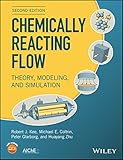Chemically reacting flow : theory, modeling, and simulation / Robert J. Kee, Michael E. Coltrin, Peter Glarborg, Huayang Zhu.
Publisher: Hoboken, NJ : John Wiley & Sons, 2017Edition: Second editionDescription: 1 online resourceContent type:- text
- computer
- online resource
- 9781119186281
- 1119186285
- 9781119186304
- 1119186307
- 660/.299 23
- TP156.T7
Includes index.
2.3.1 Viscosity2.3.2 Diffusion Coefficients; 2.3.3 Thermal Conductivity; 2.3.4 Ideal Gases; References; 3 FLUID KINEMATICS; 3.1 Path to Conservation Equations; 3.2 System and Control Volume; 3.2.1 Extensive and Intensive Variables; 3.2.2 Reynolds Transport Theorem; 3.2.3 Substantial Derivative; 3.2.4 Substantial Derivative of a Scalar Field; 3.2.5 Fluid Acceleration, Substantial Derivative of Velocity; 3.3 Stress and Strain Rate; 3.4 Fluid Strain Rate; 3.4.1 The z-r Projection; 3.4.2 The r-[theta] Projection; 3.4.3 The z-[theta] Projection; 3.4.4 Strain-Rate Tensor; 3.5 Vorticity; 3.6 Dilatation
CHEMICALLY REACTING FLOW; Contents; Preface; Acknowledgments; 1 INTRODUCTION; 1.1 Foregoing Texts; 1.2 Objectives and Approach; 1.3 What is a Fluid?; 1.3.1 Continuum Velocity; 1.3.2 Mean-Free Path; 1.3.3 Range of Scales; 1.4 Chemically Reacting Fluid Flow; 1.5 Physical Chemistry; 1.6 Illustrative Examples; References; 2 FLUID PROPERTIES; 2.1 Equations of State; 2.1.1 Ideal Gas; 2.1.2 Compressibility; 2.1.3 Virial Equation of State; 2.1.4 Cubic Equation of State; 2.1.5 Redlich-Kwong Equation of State; 2.2 Thermodynamics; 2.2.1 Ideal Gas; 2.2.2 Real Gas; 2.3 Transport Properties
3.7 Stress Tensor3.7.1 Stress Vectors and Tensors; 3.7.2 Differential Cylindrical Element; 3.7.3 Stress-Tensor Symmetry; 3.7.4 Net Force from Stress on Control Surfaces; 3.7.5 Forces on a Differential Element; 3.8 Stokes Postulates; 3.8.1 Static Fluid; 3.8.2 Principal Stress-Strain-Rate Relationships; 3.9 Transformation from Principal Coordinates; 3.9.1 Physically Based Transformation; 3.10 Stokes Hypothesis; 3.11 Summary; 4 CONSERVATION EQUATIONS; 4.1 Mass Continuity; 4.1.1 Stream Function; 4.1.2 Axisymmetric Stream Function; 4.1.3 Polar Stream Function; 4.2 Navier-Stokes Equations
4.2.1 Constant Viscosity, General Vector Form4.2.2 Cylindrical Coordinates, Constant Viscosity; 4.2.3 Incompressible Flow; 4.2.4 Incompressible, Constant Viscosity; 4.3 Species Diffusion; 4.3.1 Mass and Mole Measures; 4.3.2 Diffusive Mass Flux; 4.3.3 Stefan-Maxwell Equations; 4.4 Species Conservation; 4.4.1 Conservation Law for Individual Species; 4.4.2 Cylindrical Differential Control Volume; 4.4.3 Continuity in Terms of Composition Gradients; 4.4.4 Summation of Species Continuity; 4.5 Conservation of Energy; 4.5.1 Heat-Transfer Rate; 4.5.2 Rate of Work
4.5.3 Total Energy Equation in Vector Form4.6 Mechanical Energy; 4.7 Thermal Energy; 4.7.1 Dissipation Function; 4.7.2 Thermal Energy Equation; 4.7.3 Ideal Gas; 4.7.4 Cylindrical Coordinates, Ideal Gas; 4.7.5 Incompressible, Single-Component Fluid; 4.8 Ideal Gas and Incompressible Fluid; 4.9 Conservation Equation Summary; 4.9.1 General Vector Form; 4.9.2 Ideal Gas, Cylindrical Coordinates; 4.10 Pressure Filtering; 4.11 Helmholtz Decomposition; 4.12 Potential Flow; 4.13 Vorticity Transport; 4.13.1 Pressure and Vorticity Fields; 4.13.2 Stream Function and Vorticity
Description based on print version record and CIP data provided by publisher; resource not viewed.
There are no comments on this title.

